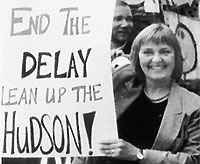|
"They're spending way too much money to be telling the truth."
By Jenny Coyle
 For 30 years, General Electric dumped PCBs into New York's Hudson River from two plants that made electrical capacitors. In 1976, when PCBs were found to be a probable cause of cancer, GE didn't stop the dumping - until ordered to do so by the federal government in 1977. And since then the company has resisted cleaning up its mess. For 30 years, General Electric dumped PCBs into New York's Hudson River from two plants that made electrical capacitors. In 1976, when PCBs were found to be a probable cause of cancer, GE didn't stop the dumping - until ordered to do so by the federal government in 1977. And since then the company has resisted cleaning up its mess.
Now, in a move applauded by the Sierra Club, the Environmental Protection Agency has completed a 10-year study and drafted a plan for GE to do so. The Hudson River is one of the country's largest Superfund sites, stretching 200 miles long, and the agency has proposed that GE dredge 40 hotspots along a 43-mile section, pulling out 100,000 pounds of the 1.3 million pounds it dumped.
GE's response? Once again, it will have to be forced to do the right thing.
The company is challenging the Superfund law in court. In a direct-mail newsletter called "River Watch," it works hard to discredit the EPA. And GE continues to lobby in Congress against clean-water laws and pollution disclosure.
"They've also launched a massive, expensive advertising campaign to convince the public there isn't a problem at all, that the river is cleaning itself up and that dredging will make things worse," said Baret Pinyoun, who directs the Club's Hudson River campaign. "They hold 'public information meetings' to spread their story, and they've advertised on television, radio, newspapers and billboards. They're spending way too much money to be telling the truth."
Among those who watch the ads is Maureen Ferraro-Davis' daughter, Kathryn. Their backyard abuts the river in the section proposed for clean up. Eleven-year-old Kathryn and her friends walk along the riverbank looking for turtles, curl their toes in the mud and skip rocks.
"She watches GE's flashy ads on television and thinks maybe the company is right, that there are ducks and herons around, so the water is clean," said Ferraro-Davis, a Sierra Club volunteer. "I remind her that we can't eat the fish because they're toxic, and that dangerous chemicals are in the mud - she just can't see them."
In November, Ferraro-Davis and others in the neighborhood had their soil tested which detected PCBs at 2.5 parts per billion - twice the level the state requires polluters to meet when cleaning up contaminated sites. The state told her that the health risks on her property are minimal, but Ferraro-Davis isn't so sure.
"It really angers me that GE is putting up such a fight about cleaning up a mess it created," she said.
The EPA's proposal would order GE to clean up the river between the cities of Troy and Fort Edward using advanced dredging technology that "vacuums" PCB-laden sediment and suctions it through a cleansing process. The sediment would be shipped by train out of the Hudson River Valley to an approved hazardous waste site.
The Sierra Club has worked to counter GE's whitewash campaign, and to pressure the EPA into standing by its plan. Aaron Mair, who grew up eating fish from the Hudson and learned to swim in its waters as a child, is happy to help.
"The debate about Hudson River pollution used to be about science and math models for the time it takes PCBs to decline," said Mair, chair of the Atlantic (New York) Chapter's environmental justice committee. "The Club turned it into a debate about human use of the river, and how it's not safe for the thousands of people who fish that river as a food source."
To call attention to the fact that fish from the river are too contaminated to eat, the Sierra Club holds an annual family fish-in where people cast their lines, but throw back anything they catch. Activists have also worked with other organizations to gather signatures on postcards and petitions, and have held informational meetings.
Most recently the Club has staged pro-cleanup rallies at the hearings being held by the EPA to gather public input on its proposal. At one rally in late January, activists waved signs while Rep. Maurice Hinchey (D-N.Y.), author George Plimpton, New York City Council Member Gifford Miller, Hudson advocate Bobby Kennedy and others spoke to a crowd of 125. Group volunteers including Don Carlson, Frank Eadie, Jack Hoyt and Margaret Hays-Young testified at the EPA hearing.
"We don't have the resources to manufacture public opinion like GE does with its multi-million-dollar campaign, so we stick to our grassroots outreach," said Pinyoun.
Take Action
The EPA is taking public comment on its Hudson River clean-up proposal until April 16. Of the alternatives in the plan, the Sierra Club favors Alternative 4, which orders GE to remove 100,000 pounds of PCBs using targeted dredging. Tell the EPA you support this science-based alternative for a safe river cleanup; it's time for GE to take responsibility for the serious risks posed to human health and wildlife by the PCBs it dumped. Write:
Alison Hess/Doug Tomchuk
Hudson River PCBs Public Comment, U.S. EPA
290 Broadway, 19th Floor
New York, NY 10007-1866
hudsoncomment.region2@epa.gov
For more information on the proposed plan, visit www.epa.gov/hudson
Up to Top
|